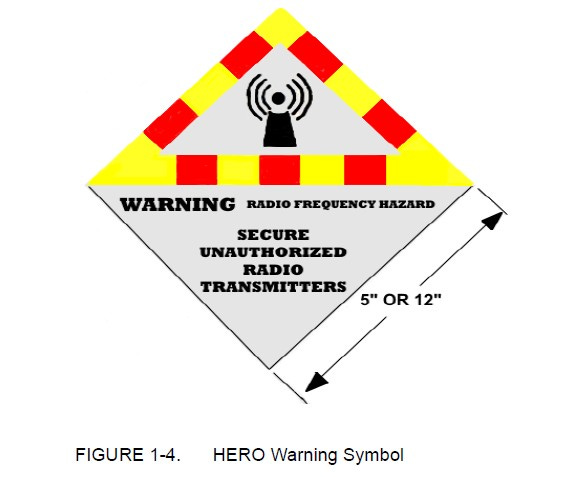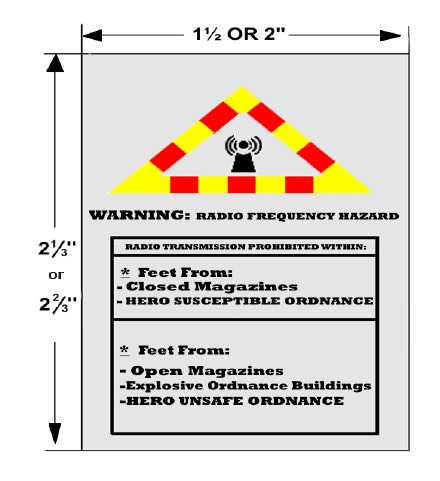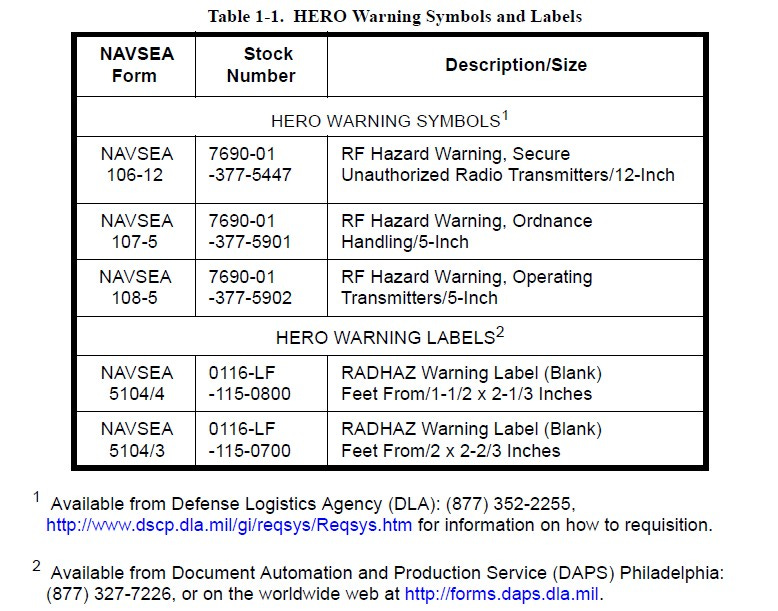Hazards of Electromagnetic Radiation to Ordnance (HERO) is a program that is concerned with preventing accidental ignition of electrically initiated devices (EID) in ordnance due to radio frequency (RF) electromagnetic fields. The following post provides information on HERO Warning Symbols and Labels when they are required. The first two publications that must be thoroughly read to understand the HERO program should be NAVSEA OP 3565 and DA Pam 385-64, Chapter 16.
The Army publication explains that EIDs are items that, when exposed to sufficient amounts of stray energies, can be unintentionally functioned, rendered unsafe, or create a dud. Explosives' safety concerns lie with items that can unintentionally function or render them in an unsafe state. Also, many forms of stray energy can affect EID's circuits. Examples include electromagnetic energy, lightning discharge, static electricity, triboelectricity (friction-generated) effects, and radio frequency (RF) energy from ground and airborne emitters.
Definitions that must be understood from the NAVSEA and DA PAM are:
Electrically Initiated Device (EID) - A single unit, device, or subassembly that uses electrical energy to produce an explosive, pyrotechnic, thermal, or mechanical output. Examples include electro-explosive devices (such as hot bridgewire, semiconductor bridge, carbon bridge, and conductive composition), laser initiators, exploding foil initiators, burn wires, and fusible links.
Electroexplosive Device (EED) - Any single discrete unit, device, or subassembly whose actuation is caused by the application of electric energy, which, in turn, initiates an explosive, propellant, or pyrotechnic material contained therein. The term electroexplosive device does not include complete assemblies with electric initiators as subassemblies but includes only subassemblies themselves. Synonymous with electric initiator.
Maximum Allowable Environment (MAE) - The highest radiated field-strength levels to which ordnance can be exposed without exceeding EID HERO margins.
HERO classification of electrically initiated ordnance includes the following:
No HERO Requirement (NHR). Ordnance without EIDs have no HERO requirements, are categorized as NHR, and are not subject to the HERO requirements. (U.S. Army, DA PAM 385-64).
HERO Safe. Ordnance item that is sufficiently shielded or otherwise so protected that all EEDs contained are immune to adverse effects (safety or reliability) when employed in its expected RF environments, provided that the general HERO requirements are observed. Percussion-initiated ordnance is exempt from HERO requirements.
HERO Susceptible. Any ordnance containing EEDs has been proven (by test or analysis) to be adversely affected by RF energy to the point that the system's safety and/or reliability is in jeopardy when the system is employed in expected RF environments.
HERO Unreliable. Any ordnance item whose performance is degraded due to exposure to the RF environment is defined as HERO UNRELIABLE ORDNANCE when its internal wiring is physically exposed…
HERO Unsafe. When internal wiring is physically exposed on any ordnance item, including HERO Safe or Susceptible Ordnance, to an RF environment that may cause accidental initiation or detonation, the item is defined as HERO Unsafe Ordnance…
Under the Department of the Army Pamphlet 385–64, signage containing HERO UNSAFE materials will be placed at and around locations. Signage will state safe transmitting distance from the location and advise rendering transmitters incapable of transmitting. Current HERO warning symbols and labels include the following.
HERO Warning Symbols. They are posted at any location where radar equipment or other possible sources of EMR might create the potential for premature ordnance initiation due to HERO. This symbol is placed along ordnance transportation routes at prescribed locations to ordnance operations (e.g., missile assembly, ammunition pier, etc.) to alert operators of mobile and portable emitter systems such as radios and cellular telephones to a potential hazard when using radios and cellular telephones past this point.
Figure 1. Example of RF warning symbol.
HERO Warning Labels. They will be affixed to portable and mobile radios for use on ship and shore stations. The HERO warning label will be affixed to mobile and portable emitter systems such as radios and cellular telephones. This warning label alerts the emitter operator to a potential hazard if the emitter is operated within the prescribed distance of ordnance operations. The label has blank spaces for inserting HERO SUSCEPTIBLE, HERO UNSAFE, or HERO UNRELIABLE separation distances in feet.
Figure 2. Example of RF warning label.
For Ordering HERO Warning Symbols And Labels. The table below provides stock numbers, descriptions, and sources of HERO warning symbols and labels. Alternate NSNs are located here at WB Part: https://www.wbparts.com/rfq/7690-01-377-5447.html.
Finally, the Electromagnetic Environmental Effects (E3) Team Online is a Navy HERO Program knowledge-management system for supporting the creation, capture, storage, and dissemination of E3 information related to the HERO Program. The tool contains the HERO database that provides a catalog of ordnance items by Department of Defense Identification Code (DODIC) with specific information about each item, including the current maximum allowable environment (MAE) and HERO status. Located here: https://e3.nswc.navy.mil.
References
Department of the Army Pamphlet 385–64, Ammunition and Explosives Safety Standards, https://armypubs.army.mil/epubs/DR_pubs/DR_a/ARN31050-PAM_385-64-000-WEB-1.pdf
NAVSEA OP 3565/NAVAIR 16-1-529 VOLUME 2, ELECTROMAGNETIC RADIATION HAZARDS (U) (HAZARDS TO ORDNANCE) (U) https://www.dau.edu/sites/default/files/Migrated/CopDocuments/NAVSEA%20OP%203565%20Vol%202.pdf






